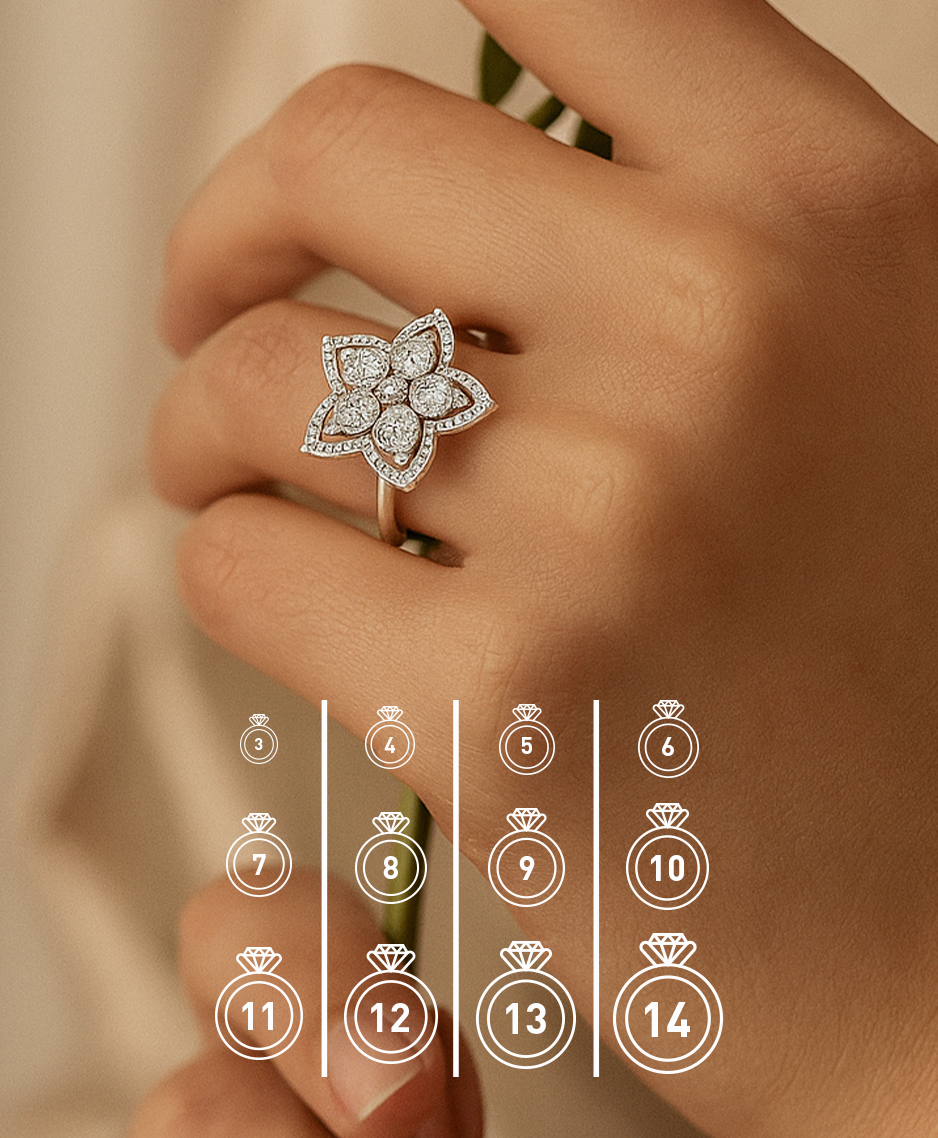Ring Size Chart - How to Measure Your Ring Size?
It's critical to determine the ideal ring size for security and comfort. Whether you're buying a basic band or an engagement ring, being able to precisely measure your ring size can save you the trouble of having to exchange it later.
What is the Best Way to Measure my Ring Size?
Using a ring-measurement instrument yields the most precise results for determining ring size. They are often inexpensive, and there are many alternatives available online.
A tiny measuring tape or a keychain lined with a gradient of ring sizes are the two types of ring-sizing instruments usually found at Jewelry shops. Ring sizes in the style of measuring tapes are easily adjusted by looping them around your finger and adjusting the belt. Try on the metal loops on the keyring-style ring sizer on your finger until you find the proper fit.
How Can I Measure My Ring Size at Home?
Follow the directions below to measure your ring size in millimeters (mm).
Step 1: Wrap a strip of paper or string around your middle finger. Verify that it goes over the knuckle.
Step 2: Mark the areas where the paper or string overlaps using a pen.
Step 3: Using a ruler with a millimeter measurement, measure the length of the paper or string from the beginning to the pen mark.
Step 4: To determine your exact size, go to the table below.
You may get your size by using the ring size conversion table below.
Ring Size Chart
US, Canada | Inside Diameter (mm) | Circumference (mm) |
3 | 14.1 | 44.2 |
4 | 14.9 | 46.7 |
5 | 15.7 | 49.3 |
6 | 16.5 | 51.9 |
7 | 17.3 | 54.5 |
8 | 18.2 | 57.2 |
9 | 18.9 | 59.3 |
10 | 19.8 | 62.3 |
11 | 20.7 | 65 |
12 | 21.5 | 67.5 |
13 | 22.3 | 70.2 |
It is recommended that you see your local jeweler for an accurate size.
What is Considered a Suitable Fit?
A ring that is both secure and comfortable should fit your finger perfectly. The following are important things to think about for a good fit:
Snugness: The ideal ring should fit snugly enough to cling to your finger without coming loose. This implies that even with your hand relaxed, it shouldn't be able to slide off or spin around your finger with ease. A well-suited ring will stay in position during daily activities and just need a small push to travel past the knuckle.
Comfort: The ring should be easy to wear even while it is tight. It shouldn't be too snug or uncomfortable in any way, like pinching or limiting blood flow. It should not cause you any discomfort or irritation even after wearing it for lengthy periods.
Mobility: Your ring should be able to move freely enough to be able to partially glide over your knuckle. This is crucial since the time of day, changes in temperature, and physical activity may all affect how big your fingers become. The ideal is a ring that fits snugly on the finger and may easily slide over the knuckle.
Temperature and Swelling: Remember that these two factors might alter the size of your finger. Your fingers could be smaller on a chilly day, and they might enlarge from heat or exercise. Make sure the ring is just the right amount of loose in colder climates or too tight in warmer ones.
Professional Sizing: You might think about having a jeweler properly size your finger for the best fit. They are able to precisely measure your finger and take into consideration any size variances. They may also advise you on the best ring size depending on your tastes and way of life.
Getting your ring to fit perfectly guarantees comfort and security, allowing you to enjoy wearing your commitment and love symbol worry-free.
In conclusion, accurately measuring your ring size is crucial for ensuring that your ring is both comfortable and secure. By using professional ring-sizing tools or following simple at-home methods, you can find the perfect fit that accommodates daily wear and fluctuations in finger size. Remember, consulting with a jeweler can provide additional assurance of accuracy.
